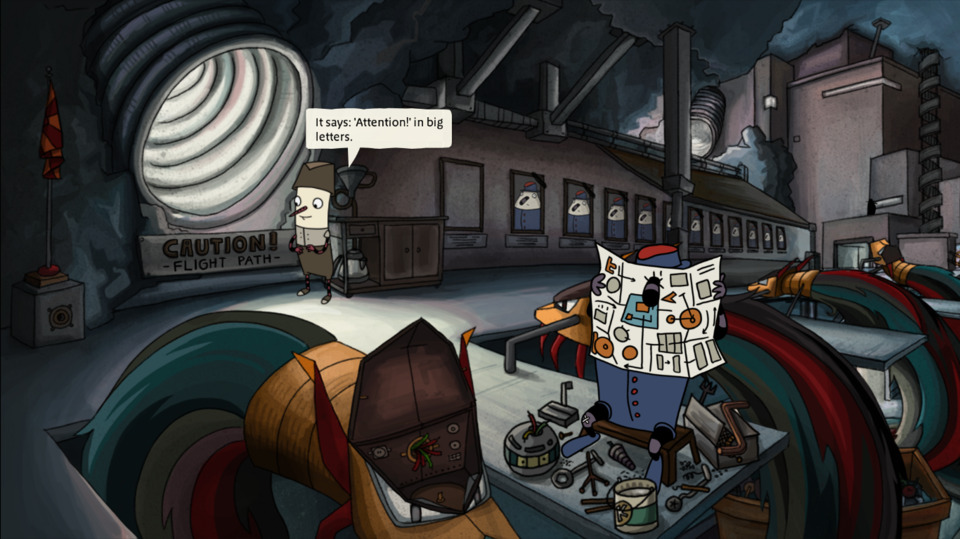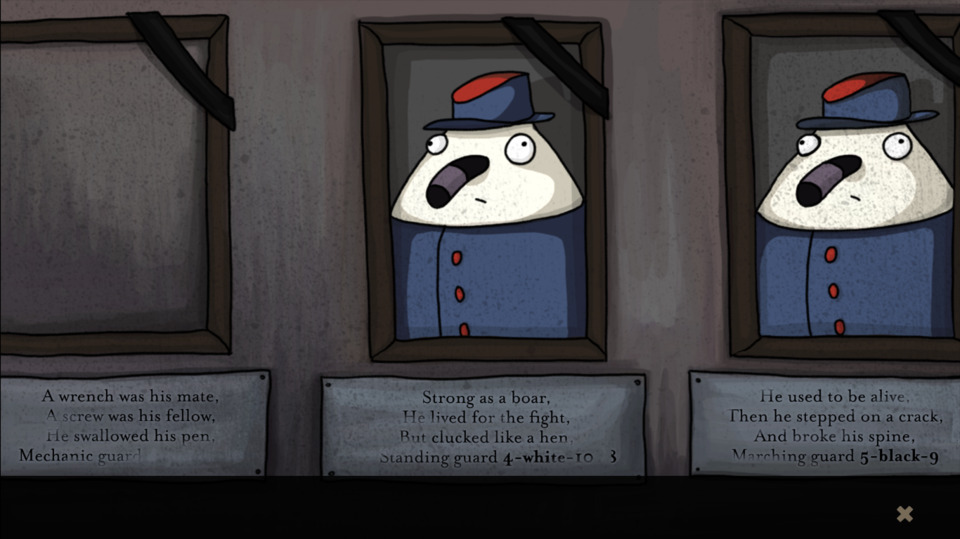
It's another German adventure game created in the classic point-n'-click style - similar Teutonic Indie throwbacks include King Art Games's The Book of Unwritten Tales and Daedalic's Deponia - but I picked this one out for a semi-cogent reason: it saw a sequel in 2017, and is therefore something I might want to look into as part of my other year-long project for 2021. Studio Fizbin's The Inner World is about as traditional as this genre gets, including some pretty obtuse puzzle design, but it also has a strong narrative drive and a certain amount of respect for the player's time and perspicacity, or lack thereof as the case may be.
The Inner World is set in an inverted planet: that is, the known world is an empty sphere surrounded by dirt that apparently goes on forever in all directions, with cities and forests lining the inside of this hollow orb. I've always been a fan of inverted worlds in games - Quintet's Terranigma and Atlus's Shin Megami Tensei: Nocturne come to mind due to their cool overworld visuals - so this was automatically a point in the game's favor. The protagonist Robert, true to genre tradition, is a mostly weak-willed but goodnatured hero who'd be morally beyond reproach were it not for a chronic (though gameplay-necessary) need to steal anything that isn't nailed down, and occasionally nailed down items as well. His quiet life as a monk apprentice is upended after a chance encounter with a thief girl and her pet pigeon, eventually leading him to discover the secret behind the world's biggest issue - people living in fear of constant attacks by petrifying "wind god" dragons - and the mysteries of his own origin.
There are specific qualities I always like to see in a modern graphic adventure game, and to The Inner World's credit it gets most of the small stuff right, even if the bigger stuff can be occasionally underwhelming. To start the with the former: the game compartmentalizes itself in a roughly episodic nature (though not in a literal, buying episodes piecemeal manner) in that the protagonist and his eventual partner Laura are frequently whisked off to a new area of the game and leaves the previous (as well as most of their now-useless inventory) behind to start fresh in each of the game's chapters. It also has a function that highlights all hotspots on the screen, which is always a positive accessibility feature if nothing else. These factors greatly ameliorate the occasions where the game might temporarily stump you with a puzzle solution that requires a little more lateral thinking, or specifically thinking like an adventure game designer, and you're having to experiment a little to make progress. The "bigger stuff" I alluded mostly concerns the writing: the game was not written nor was it voiced by native English speakers, and it makes itself known in myriad smaller ways that would be difficult to pick out by anyone who hadn't been speaking the language since small times.
I do like the story so far though, even if it is a little fractured due to those sudden scenery changes. The diehard adventure game fanbase in Germany - not to generalize too much - have a huge affection for a UK franchise called Simon the Sorcerer, which took what felt like traditional fantasy/fairytale stories and injected them with a certain '90s genre savviness and satirical comedy (the Discworld games did something similar, building on the tone set by the books) that often erred towards comic misanthropy, especially as far as the game's self-serving, anti-hero protagonist was concerned. The Inner World definitely has shades of something similar going on with its sense of humor, though it's not quite as sarcastic and mean-spirited: Laura, your companion for most of the game, is very much the type of character who'd rather brute force a problem than try to find a solution that doesn't involve violence and hurt feelings, but she'll usually follow Robert's lead until she decides to strike out on her own. Kind of feels like the game is having its cake and eating it too.


Ultimately, the Inner World is a deliberate and affectionate '90s point-and-click homage driven by some welcome quality-of-life features that the games it hearkens back to didn't enjoy, though is at equal turns let down by its delivery of jokes that perhaps didn't translate well. Its ambition as a game doesn't really extend beyond that, but given it was made and released in the midst of the hype surrounding Double Fine's Broken Age Kickstarter campaign I could see other studios getting into the spirit of bringing back that specific era, before companies like Wadjet Eye eventually made it their stock and trade. Given that it's a 2013 Indie game you can also expect it to be a little shorter and less polished than the Indie adventures of today, but it still looks professional enough (plus its world design is definitely distinctive, and that can count for a lot) and appears to have an even more ambitious sequel that I'm looking forward to trying someday.
Rating: 3 out of 5.
| < Back to 207: Glittermitten Grove | The First 100 | The Second 100 | > Forward to 209: Eschalon: Book III |
Post-Script: In the final chapter, which I started just after the review went up, I hit a game-breaking bug. A certain vital item just up and vanishes from the game. Since the game is constantly auto-saving, it's now in a "dead man walking" state and cannot be fixed unless I start over from the beginning. Needless to say this is not a good look for a game that has ostensibly been patched at least once since it came out eight years ago. Gonna have to recommend you maybe avoid the Steam version (and the iOS version, since it happens there too). Life's too short for games that fall flat on their face at the final hurdle.

Log in to comment